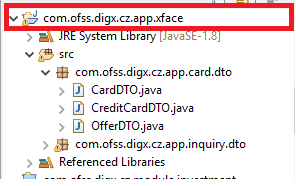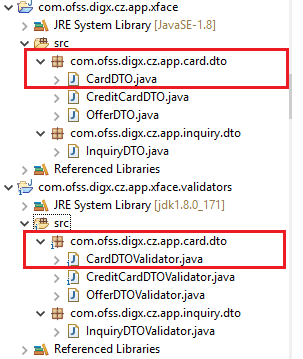14 Manual to create Validators
- Import the project containing customized DTO in eclipse
workspace
- Create project in the workspace for valiadator classes. Name the
project by appending ’.validators’ to the name of project containing DTOs
- Create the validator class for each of the DTO. Maintain the same
package structure as that of DTO project while creating the validator classes.
To name the validator, use the DTO name appended with prefix ‘Validator’.
Use following steps to create validator class:
In this document, we will use CardDTO, OfferDTO, CreditCardDTO as example to create validators. CardDTO extends DataTransferObject and CreditCardDTO extends CardDTO.
For these DTOs, CardDTOValidator, OfferDTOValidator and CreditCardDTOValidator will be created.
Each validator class must extend a parent DTO validator class.
If Request DTO extends DataTransferObject then the validator class should extend ‘com.ofss.digx.app.dto.validator.AbstractDTOValidator’.
E.g.
public class CardDTOValidator extends AbstractDTOValidator implements
IDTOValidator {
If request DTO extends another request DTO then the validator class should extends the validator class of parent DTO.
e.g.public class CreditCardDTOValidator extends
CardDTOValidator implements IDTOValidator {
- Each validator class must implement the interface
‘com.ofss.digx.app.dto.validator.IDTOValidator’Each validator should be a singleton class and must contain ‘getInstance’ method to return validator class instance. The class can be made singleton by any method. One of the method is given in following snippet.
protected CreditCardDTOValidator() { } /** * @return instance of {@link CreditCardDTOValidator}. */ public static CreditCardDTOValidator getInstance() { return CreditCardDTOValidatorHolder.INSTANCE; } /** * The class holds the instance of {@link CreditCardDTOValidator}. */ private static class CreditCardDTOValidatorHolder { /** * private instance variable {@value new CreditCardDTOValidator()}. */ private static final CreditCardDTOValidator INSTANCE = new CreditCardDTOValidator(); } - Validator class should override ‘validateInput’ with signature as
given
below:
@Override public void validateInput ( IValidatable validatable, String key, String parentName,List<ValidationError> validationErrors ) { - In ‘validateInput’ method: include following content in the
beginning-
-
String parent = parentName != null ? parentName : validatable.getClass().getName(); String fullKey = (key != null ? (key + ".") : ""); super.validateInput(validatable, key, parent, validationErrors);(The super.validateInput validates the fields of parent class by calling parent validator’s ‘validateInput’ method.
- validatable’ parameter of ‘validateInput’ should be casted
to DTO which we want to validate. For example, in case of
CardDTOValidator, CardDTO is to be validated. Therefore, below code
should be used for
casting
CardDTO cardDTO = (CardDTO) validatable; - Create a HashMap of String as key and Object as value as in
below
snippet
Map<String,Object> fieldsMap =new HashMap<String,Object>();Add all fields of DTO in hashmap one by one.
‘fullKey’ appended with particular fieldname should be inserted as key of hashmap and corresponding field as value of hashmap .
For eg in case of CardDTO below snippet should be added to CardValidatorMap<String,Object> fieldsMap = new HashMap<String,Object>(); fieldsMap.put(fullKey + "id",cardDTO.getId()); fieldsMap.put(fullKey + "cvv",cardDTO.getCvv()); fieldsMap.put(fullKey + "active",cardDTO.isActive()); - If some DTO have other DTO in its attribute, then to
validate attribute level DTO, corresponding DTOs validator should be
called.
For e.g. CardDTO contains a field cardProductDTO of type CardProductDTO. So CardValidator should have following snippet to validate field of type CardProductDTO.
if(cardDTO.getCardProductDTO() != null) { DTOValidatorFactory.getInstance().getValidator(cardDTO.getCardProductDTO()).validateInput (cardDTO.getCardProductDTO(),fullKey + "cardProductDTO", parent, validationErrors); } fieldsMap.put(fullKey + "cardProductDTO",cardDTO.getCardProductDTO()); - If some DTO contains list of objects, include following
snippet for its
validation.
if(cardDTO.getOffers() != null && !cardDTO.getOffers().isEmpty()) { int dtoVarIndex = 0; for(OfferDTO dtoVar : cardDTO.getOffers()) { DTOValidatorFactory.getInstance().getValidator(dtoVar).validateInput (dtoVar, fullKey + "offers#" + dtoVarIndex, parent, validationErrors); dtoVarIndex++; } } fieldsMap.put(fullKey + "offers",cardDTO.getOffers() ); - Finally add following method to validate
parameters.
DefaultDTOValidator.validateParams(fieldsMap,parent,validationErrors);
-


